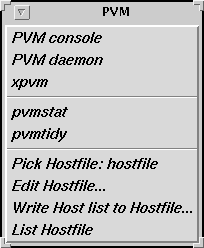




Next: The PVMmake Menu
Up: The PADE User's
Previous: The Graph Window
The PVM menu is used to configure and execute PVM and related programs.
It is pictured in Figure 5.6. The menu entries are:

Figure 5.6. The PVM menu
- PVM console -- brings up a PVM console, and starts PVM
if it is not already running. If a PVM hostfile has not already been
selected (see below), then the user will prompted to create or select a
hostfile, or to start PVM without a hostfile. The PVM console will come
up in a term window (for example xterm
, but the type is determined by
user preferences, Section 5.4), and may be left up or
closed with the PVM console command quit
. It is recommended that the
console window be left open in case the PVM application ``hangs'' (which will
also cause PADE to hang), in which case the console is required to terminate
the application.
- PVM daemon -- starts the PVM daemon without bringing up
the console. As with PVM console above, the user will be prompted
if a hostfile has not been selected.
- xpvm -- launches the XPVM
application, a GUI interface to
PVM.
- pvmstat -- runs the CAML Utility pvmstat
. This returns
information about the status of the virtual machine.
- pvmtidy -- runs the CAML Utility pvmtidy
. This removes
all spurious pvmd.*
files from the nodes of the virtual machine and kills
any hopelessly lost PVM daemons, in case PVM was not shut down gracefully.
- Pick Hostfile... -- selects an existing file as the PVM
hostfile. It brings up a file browser.
- Edit Hostfile... -- creates or edits a PVM hostfile. It
brings up a PADE Edit File window.
- Write Host list to Hostfile... -- creates a PVM hostfile.
The file will contain the same list of hosts as in the current PADE data.
It brings up a file browser to select the file to write the
host list to.
- List Hostfile -- displays the current PVM hostfile.





Next: The PVMmake Menu
Up: The PADE User's
Previous: The Graph Window
[email protected]

